Imagine a technology that can create original songs, write marketing copy, or even design new products with just a few instructions. That’s Generative AI, and its market is booming.
Generative AI market aims to touch a significant 69.85 billion by the end of 2025. This isn’t just a bump; it is a rocket ship!
Looking further ahead, the market size is expected to reach a mind-boggling $1,005.07 billion by 2034, with a Compound Annual Growth Rate (CAGR) of 44.2% between 2025 and 2034. To put this in perspective, this growth rate is even faster than the cloud computing boom of the 2010s.
Here is a quick look at how the market size is shaping up:
| Year | The Market Size of Generative AI |
| 2024 | $25.86 billion |
| 2025 | $37.89 billion |
| 2026* | $55.51 billion |
| 2027* | $81.32 billion |
| 2028* | $119.13 billion |
| 2029* | $174.52 billion |
| 2030* | $255.67 billion |
| 2031* | $374.56 billion |
| 2032* | $548.74 billion |
| 2033* | $803.90 billion |
| 2034* | $1,005.07 billion |
*(Projected data)
North America currently leads the charge, holding 41% of the revenue share in Generative AI. This makes sense, as many of the key players in Generative AI call North America home.
Europe follows with a 28% market share, and Latin America holds 6%. However, keep an eye on the Asia Pacific region, which currently accounts for 22% of the revenue share. This region is a growth powerhouse, expecting a remarkable 27.6% CAGR from 2025 to 2034.
Let’s visualize the market share by region:
| Region | Generative AI Market Share |
| North America | 41% |
| Europe | 28% |
| Asia Pacific | 22% |
| Latin America | 6% |
| MEA | 3% |
Also read about: ChatGPT Statistics
What Drives This Growth? The Components of Generative AI
The Generative AI market isn’t just one big blob; it breaks down into different segments. The software segment dominates, holding a significant 65.50% market share.
This includes the powerful underlying models and applications we interact with. The remaining 34.5% goes to other essential services that support Generative AI.
Within the software segment, the transformers segment alone accounts for 42% of the market share. Transformers are a type of neural network architecture that has been incredibly effective in areas like natural language processing.
Generative AI in Action: Industries Embracing Innovation
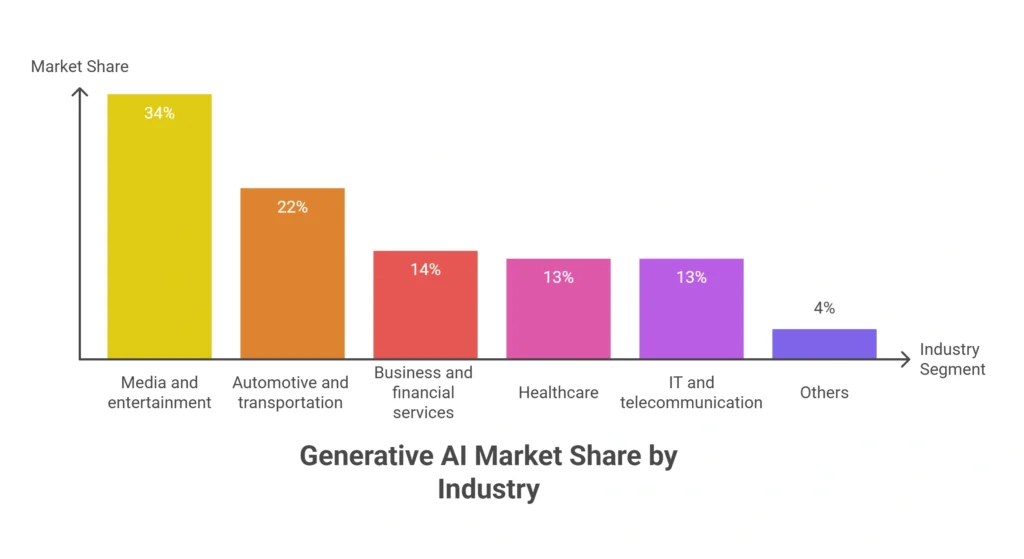
Generative AI is not just a concept; industries are actively putting it to work. The media and entertainment industry is a big believer, taking 34% of the Generative AI market share.
This makes sense, as Generative AI can help create everything from scripts and music to visual effects. The automotive and transportation segment also shows strong adoption with a 22% market share, likely using AI for design, simulations, and intelligent systems.
Business and financial services account for over 14% and are expected to grow the fastest, with a projected 36.4% CAGR between 2025 and 2034. They are leveraging Generative AI for things like fraud detection, personalized financial advice, and automated report generation.
Here’s a breakdown of market share by industry:
| Segment | Market Share of the Segment |
| Media and entertainment | 34% |
| Automotive and transportation | 22% |
| Business and financial services | 14% |
| Healthcare | 13% |
| IT and telecommunication | 13% |
| Others | 4% |
Also read about: DeepSeek AI Statistics
Who is Adopting Generative AI and How?
Across different sectors in the United States, we see varied adoption rates. The marketing and advertising industry leads with 37% of businesses using Generative AI.
This is a natural fit for creating engaging content and personalized campaigns. The technology industry follows closely at 35%.
Interestingly, the healthcare industry is still catching up, with only 15% adoption, but this number is expected to grow significantly as AI tools for diagnosis and drug discovery become more mature.
Here’s how different industries in the U.S. are adopting Generative AI:
| Industry | Rate of Generative AI Adoption in Workplace |
| Marketing and Advertising | 37% |
| Technology | 35% |
| Consulting | 30% |
| Teaching | 19% |
| Accounting | 16% |
| Healthcare | 15% |
When we look at different generations in the U.S., Gen Z is leading the way, with 29% of them adopting Generative AI in their workplaces.
Gen X is right behind them at 28%, and Millennials are at 27%. This shows that younger generations are quickly integrating these powerful tools into their professional lives.
| Generation | The Adoption Rate of Generative AI |
| Gen Z | 29% |
| Gen X | 28% |
| Millennials | 27% |
The overall adoption of AI in product development companies worldwide is also seeing a dramatic shift. In 2022, a large portion of companies had only “Limited adoption” of AI (42%), while “Widescale adoption” was at 23% and “AI is critical” was at 11%.
By 2025, these numbers are projected to flip significantly, with “Widescale adoption” reaching 46% and “AI is critical” at 21%. This indicates a clear move towards integrating AI as a core component of product development strategies.
| Adoption of AI in product development | 2025 | 2022 |
| Not Using | 2% | 6% |
| Piloting use cases | 13% | 17% |
| Limited adoption | 18% | 42% |
| Widescale adoption | 46% | 23% |
| AI is critical | 21% | 11% |
Also read about: Grok AI Statistics
The Power Players: Key Generative AI Technologies
Several companies are at the forefront of the Generative AI revolution, creating the tools that are changing industries.
Companies like OpenAI, Midjourney, Lightricks, Hugging Face, Jasper, Glean, and Stability AI are developing technologies such as ChatGPT, Google Gemini, JasperAI, and Midjourney. Let’s delve into some interesting facts and figures about these popular platforms.
ChatGPT: The Trailblazer
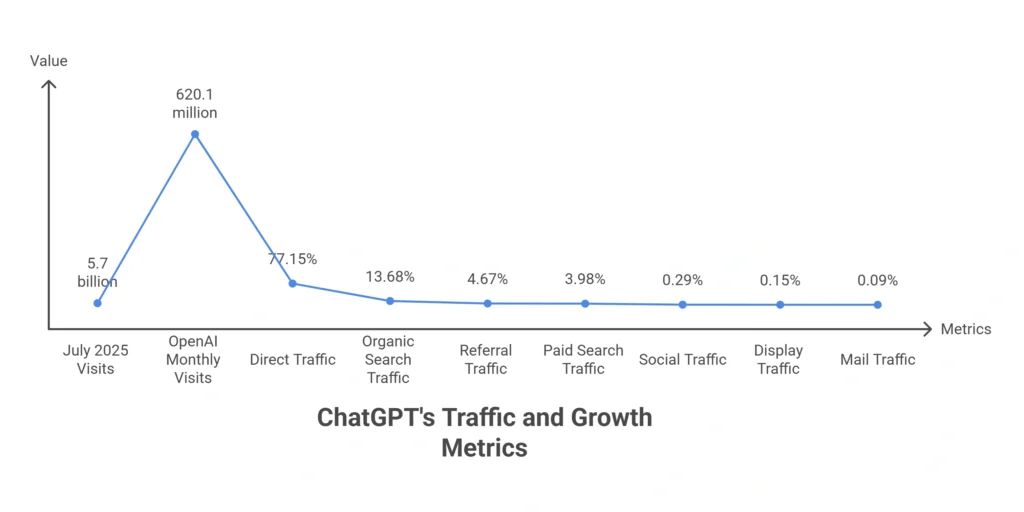
ChatGPT burst onto the scene and quickly became a household name. It achieved one million users in just two days – an unprecedented feat! To put this in context, TikTok took nine months to reach 100 million users, and Facebook took 4.5 years for the same milestone.
As of July 2025, ChatGPT boasts over 5.7 billion page visits, making it the most visited Generative AI platform. OpenAI, its creator, comes in second with 620.1 million monthly visits.
Here’s how ChatGPT’s monthly visits have trended:
| Month | Number of visitors on ChatGPT website |
| July 2025 | 5.7 billion |
| June 2025 | 5.4 billion |
| May 2025 | 5.5 billion |
Most of ChatGPT’s traffic, an impressive 77.15%, comes directly to the site. Organic search is the second largest source, contributing 13.68%.
| Traffic sources for ChatGPT | Percentage of traffic |
| Direct | 77.15% |
| Organic Search | 13.68% |
| Referrals | 4.67% |
| Paid Search | 3.98% |
| Social | 0.29% |
| Display | 0.15% |
| 0.09% |
Midjourney: Visualizing Imagination
Midjourney is an AI that generates stunning images from text prompts. It operates primarily through its Discord channel, which has over 14.5 million registered members, with 7.5% of them active at any given time. As of July 2025, Midjourney recorded 18.40 million total monthly visits.
Monthly visitors on Midjourney:
| Month | Number of monthly visitors recorded |
| July 2025 | 18.4 million |
| June 2025 | 15.9 million |
| May 2025 | 14.7 million |
The United States accounts for the largest share of Midjourney traffic, with 19.74%, followed by the Republic of Korea (9.17%) and the United Kingdom (4.56%).
| Country | Percentage of Midjourney users |
| United States | 17.24% |
| Brazil | 4.98% |
| India | 4.94% |
| Germany | 4.30% |
| United Kingdom | 4.16% |
| Others | 64.37% |
Jasper: Your Content Creation Companion
Jasper is an AI platform that helps users generate various forms of content, including text and images, based on provided prompts. In July 2025, Jasper had 1.16 million monthly visitors.
Here’s a look at Jasper’s monthly visitor numbers:
| Month | Number of monthly visitors |
| July 2025 | 1.16 million |
| June 2025 | 1.09 million |
| May 2025 | 1.3 million |
The United States also leads in Jasper AI usage, with 31.11% of its users residing there, followed by Brazil at 5.71%.
| Country | Percentage of users |
| United States | 31.11% |
| Brazil | 5.71% |
| India | 4.41% |
| United Kingdom | 3.51% |
| Colombia | 3.03% |
| Others | 52.23% |
Regarding gender distribution, 60.91% of JasperAI users are male, while 39.09% are female. The largest age group using JasperAI is 25 to 34 years old, accounting for 36.73%.
| Age group | Percentage of Jasper AI users |
| 18 to 24 years | 25.71% |
| 25 to 34 years | 36.73% |
| 35 to 44 years | 18.85% |
| 45 to 54 years | 10.0% |
| 55 to 64 years | 5.52% |
| More than 65 years | 3.18% |
Google Gemini: The Rising Star
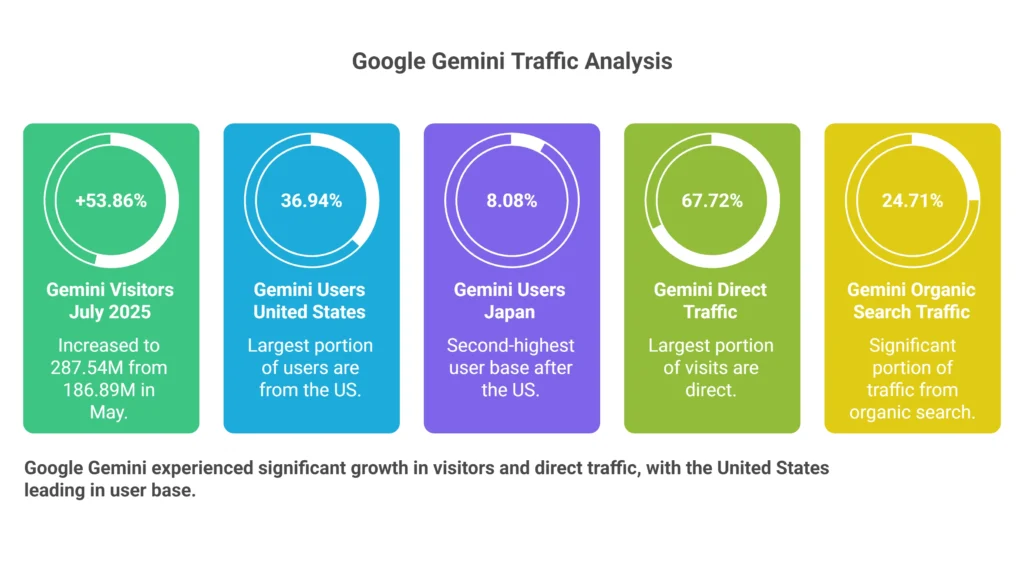
Google Gemini (formerly Bard) has made significant strides in the Generative AI competition, especially with recent updates. In July 2025, Gemini saw a huge jump in visitors, reaching 287.54 million, up from 186.89 million in May 2025.
| Month | Number of visits on Google Bard |
| July 2025 | 287.54 million |
| June 2025 | 265.71 million |
| May 2025 | 186.89 million |
The United States accounts for the majority of Gemini users at 36.94%, with Japan being the second-highest at 8.08%. Direct traffic makes up the largest portion of Gemini’s visits, at 67.72%.
| Source of traffic | Percentage of traffic received by Google Gemini |
| Direct Traffic | 67.72% |
| Organic search | 24.71% |
| Referrals | 4.88% |
| Paid search | 0.53% |
| Social | 2.05% |
| 0.10% | |
| Display | 0.01% |
Also read about: AI Market Size Statistics
Beyond the Big Players: Broader Generative AI Trends
Generative AI’s influence extends far beyond these major platforms. Here are some additional noteworthy statistics:
- McKinsey & Company reports that nearly 50% of its approximately 40,000 employees (around 15,000 people) actively use ChatGPT and other Generative AI tools. This shows a significant internal adoption by a major consulting firm.
- A recent survey by Altman Solon indicates that 25% of companies in the United States are currently using Generative AI tools.
- The State of AI report predicts that Generative audio tools will attract over 100,000 developers, indicating a growing interest in AI for sound and music creation.
- Gartner forecasts that by the end of 2025, almost 30% of newly discovered drugs will be found with the help of AI. This highlights AI’s transformative potential in healthcare.
- Japan’s Prime Minister has openly supported the use of Generative AI like ChatGPT for industrial work, showing a national embrace of the technology. Additionally, Micron Technology is investing approximately $3.6 million in Japan to focus on Generative AI chip innovation, with strong government support.
The Bigger Picture: Global AI Trends and Workforce Impact
Looking at the broader AI landscape, adoption is accelerating globally. In 2025, 35% of businesses have fully deployed AI in at least one function, and 42% are actively experimenting or piloting AI tools. Only 13% have no AI adoption plans, meaning almost four out of five organizations are engaging with AI in some way.
AI is not just about automation; it is transforming the workforce. The World Economic Forum (WEF) forecasts that AI will create 97 million new jobs globally by 2025, while displacing 85 million (mostly repetitive roles). This results in a net gain of 12 million jobs. New roles are emerging, such as AI trainers, prompt engineers, and AI ethicists.
Here are some of the top roles created by AI:
- Data Scientists
- Machine Learning Engineers
- AI Researchers
- Prompt Engineers
- AI Ethicists
- AI Business Developers
Roles that are at higher risk of displacement include:
- Data Entry Clerks
- Administrative Assistants
- Factory Workers (repetitive tasks)
- Customer Service Representatives (basic queries)
Many platforms are offering opportunities for upskilling and education in AI, including Google Digital Garage, AWS AI Ready, Coursera & DeepLearning.AI, and Hugging Face Open Education.
AI Across Industries: A Multiplier Effect
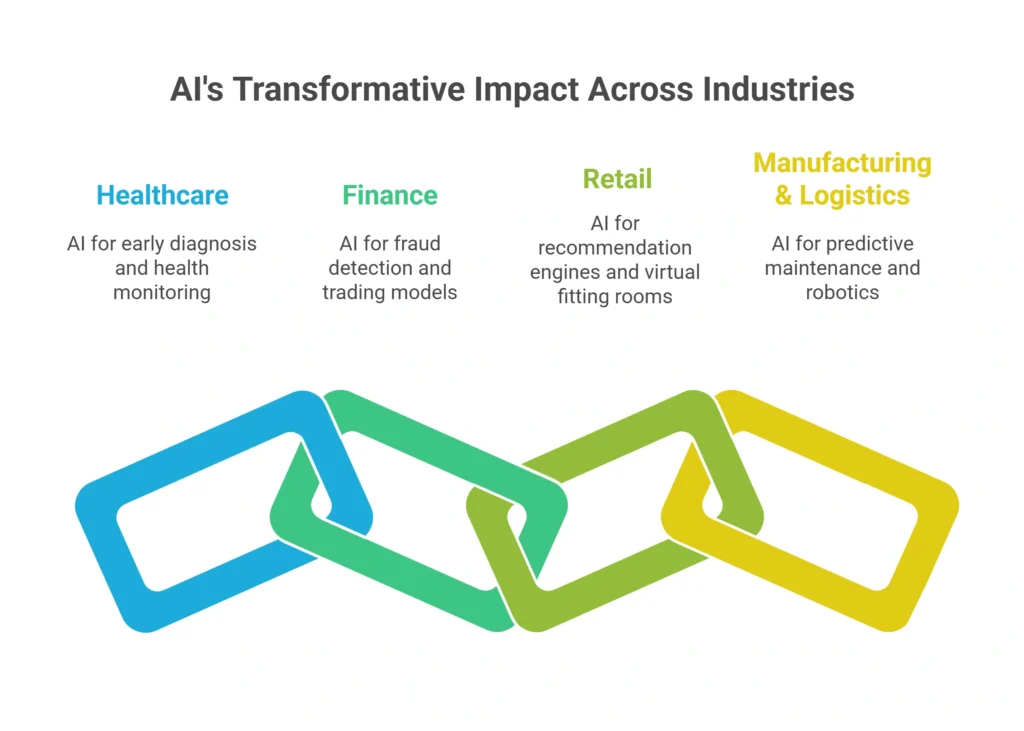
AI acts as a multiplier, impacting various industries differently:
- Healthcare: AI is already used for early diagnosis, remote patient triage, and predictive health monitoring. Emerging trends include Generative AI summarizing electronic health records (EHR) and translating medical documentation. The value creation forecast for AI in healthcare is $194 billion by 2030.
- Finance: Applications include AI-driven fraud detection, enhanced underwriting, and sentiment-based trading models. JPMorgan Chase alone has over 300 AI use cases in production.
- Retail: AI powers recommendation engines, dynamic pricing, and virtual fitting rooms. Future trends involve real-time customer segmentation and chat-driven e-commerce.
- Manufacturing & Logistics: Current uses include predictive maintenance, route optimization, and computer vision for quality assurance. Robotics and AI integration for delicate tasks and Generative AI for designing custom components are emerging.
Investment in AI Startups: The Fuel for Innovation
Investment in AI startups continues to surge. In 2025, $107 billion was deployed globally into AI startups, marking a 28% year-over-year increase. AI startups now account for 26% of all global VC funding. The UK remains Europe’s top destination for AI capital, with over £4.5 billion invested in 2024–2025.
Investment is focusing on areas like:
- Generative AI Infrastructure: Developing the foundational models and platforms.
- Vertical AI Solutions: AI tailored for specific industries like legal, healthcare, or finance.
- AI Safety & Ethics: Ensuring responsible development and deployment of AI.
Navigating the Future: AI Regulation and Ethics
As AI becomes more powerful, the need for robust regulation is critical. However, there is no global consensus yet. Key policy innovations include the UK Frontier AI Taskforce for safety testing, the EU AI Act which categorizes applications by risk level, and the US Executive Order on AI (2023) focusing on model evaluations and workforce protections.
Major risks include:
- Hallucinations: AI models sometimes invent facts.
- Bias & Fairness: AI systems can perpetuate or amplify existing societal biases.
- Data Privacy: Concerns about how data is used and secured.
- Cybersecurity: AI systems can be vulnerable to attacks.
- Job Displacement: The impact on employment.
Solutions underway involve AI audits, watermarking AI-generated content, and open model registries for transparency. Effective regulation will likely depend on international cooperation, compute registries, and increased funding for AI assurance.
Predictions for 2025–2030: The Embedded AI Society
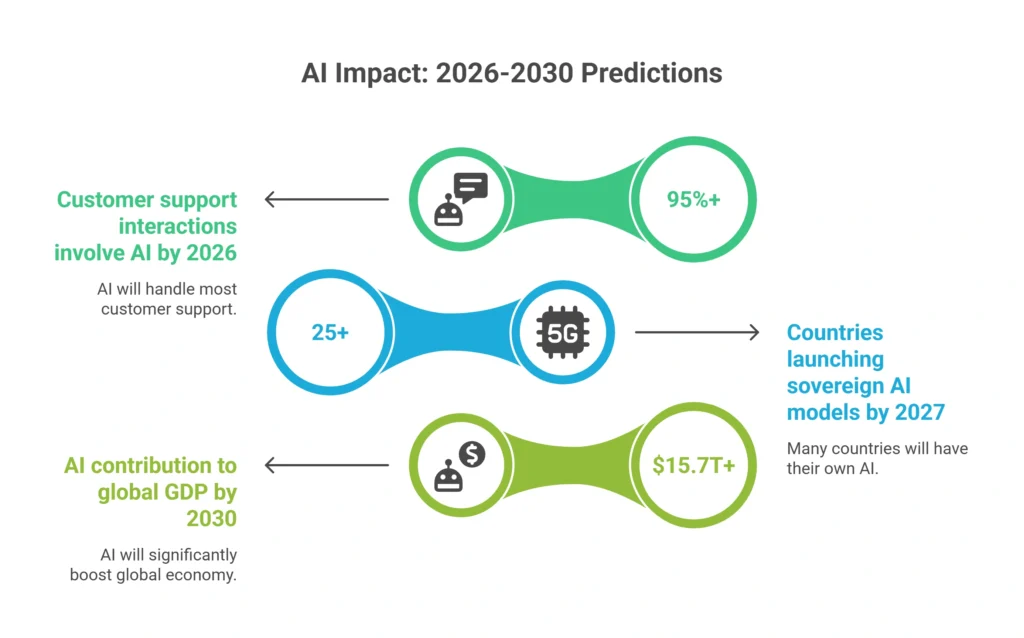
The future of AI is not just evolution; it is acceleration.
- By 2026, over 95% of customer support interactions will involve AI.
- By 2027, sovereign AI models will be launched in at least 25 countries.
- By 2028, AI-generated scientific papers will outpace human-only authored papers in quantity.
- By 2030, AI will contribute over $15.7 trillion to global GDP.
Strategic frontiers include the development of sovereign AI models tailored to local languages and values, “compute nationalism” as nations race to control chip manufacturing, the convergence of biology and AI for personalized medicine, and the rise of AI + Robotics for industrial and personal services. Culturally, “AI literacy” will become mandatory in education, and national compute infrastructures will be classified as critical infrastructure.
The AI Revolution: A Collective Journey
Artificial Intelligence in 2025 is no longer a concept; it is a defining force. It is creating economic value, disrupting labor markets, and reimagining infrastructure. While it offers immense promise, it also brings profound questions about who builds it, who controls it, and who benefits.
For founders, this is the time to build AI-native companies. For governments, it is crucial to balance innovation with safety. For corporations, it means scaling beyond pilots and rethinking workflows. For civil society, it is an opportunity to demand transparency, fairness, and inclusion.
The AI revolution will not be televised; it will be embedded into every facet of society. The real question is not whether AI will change our world—it already has—but whether we will guide that change wisely, justly, and collectively.
Quora and Reddit Insights: What Users Are Asking
Beyond the statistics, real-world questions on platforms like Quora and Reddit give us a pulse on user concerns and interests regarding Generative AI. Many users are asking:
- “How can I use Generative AI for passive income?” This reflects a strong interest in leveraging AI tools like ChatGPT or Midjourney for content creation, copywriting, or art generation to create new revenue streams.
- “What are the best free Generative AI tools for beginners?” Accessibility is key, and people are looking for low-barrier entry points to experiment with AI without significant investment.
- “Is Generative AI going to replace my job, and if so, how can I adapt?” This is a prevalent anxiety, highlighting the need for discussions around upskilling and the changing nature of work.
- “How can I ensure my data is private when using Generative AI tools?” Data privacy and security are top-of-mind, especially as more personal or sensitive information might be inputted into these models.
- “What are the ethical implications of AI-generated content (e.g., deepfakes, copyright)?” This shows a growing awareness of the societal challenges and legal complexities introduced by Generative AI.
- “How do I write effective prompts for Generative AI?” Users are actively seeking ways to improve their interaction with AI, understanding that good input leads to better output.
- “What’s the difference between various Generative AI models like GPT, Gemini, and Claude, and which one is best for my specific task?” People are moving beyond just knowing about Generative AI to understanding the nuances and specialized strengths of different models.
These questions underscore the practical, ethical, and personal impact Generative AI is having, pushing for more educational content, transparent tools, and responsible development.
FAQs About Generative AI Statistics
1. What is the projected market size of Generative AI by 2025?
The Generative AI market is projected to reach an impressive $69.85 billion by the end of 2025, showing a significant increase from its current size.
2. Which industries are leading in the adoption of Generative AI?
The marketing and advertising industry leads with 37% adoption in the workplace, followed closely by the technology industry at 35%, and media and entertainment holding the largest market share in terms of revenue.
3. How quickly did ChatGPT acquire its user base?
ChatGPT gained one million users in just two days of its launch, and it crossed 100 million users in only two months, demonstrating an unprecedented rate of adoption compared to other major platforms.
4. What is the expected impact of AI on the global workforce by 2025?
By 2025, the World Economic Forum forecasts that AI will create 97 million new jobs globally while displacing 85 million, resulting in a net gain of 12 million jobs, with a significant shift in required skills.
5. What are some of the key risks and ethical concerns associated with Generative AI?
Key risks include AI hallucinations (inventing facts), biases in AI systems, concerns about data privacy, cybersecurity vulnerabilities, and uncertainties around the legal ownership and copyright of AI-generated outputs.
Also Read:
- Chatbots Statistics
- Voice Search Statistics
- Link Building Statistics
- Infographics Statistics
- Meta AI Users Statistics
Conclusion:
In conclusion, the Generative AI market is experiencing rapid and explosive growth, projected to reach $69.85 billion by 2025 and over $1 trillion by 2034.
This technology is revolutionizing industries like marketing, healthcare, and entertainment, with its adoption expanding across various sectors.
While opportunities are abundant, challenges such as job displacement, ethical concerns, and data privacy remain crucial topics.
As AI continues to evolve, it will play a defining role in shaping the future of work, business, and society. The key to harnessing this power lies in understanding its potential while navigating its risks responsibly.
Source: Precedence Research. Statista
